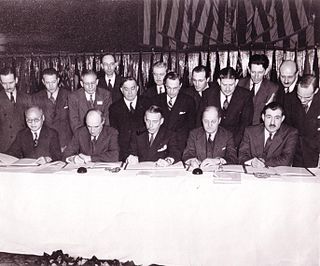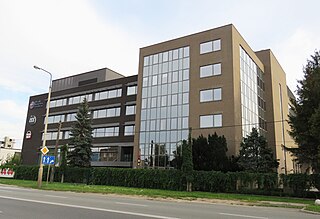
General aviation (GA) is defined by the International Civil Aviation Organization (ICAO) as all civil aviation aircraft operations except for commercial air transport or aerial work, which is defined as specialized aviation services for other purposes. However, for statistical purposes, ICAO uses a definition of general aviation which includes aerial work.

Commercial aviation is the part of civil aviation that involves operating aircraft for remuneration or hire, as opposed to private aviation.

The Civil Aeronautics Board (CAB) was an agency of the federal government of the United States, formed in 1938 and abolished in 1985, that regulated aviation services and conducted air accident investigations. The agency was headquartered in Washington, D.C.

The Convention on International Civil Aviation, also known as the Chicago Convention, established the International Civil Aviation Organization (ICAO), a specialized agency of the United Nations charged with coordinating international air travel. The Convention establishes rules of airspace, aircraft registration and safety, security, and sustainability, and details the rights of the signatories in relation to air travel. The convention also contains provisions pertaining to taxation.
Pilot licensing or certification refers to permits for operating aircraft. Flight crew licences are issued by the civil aviation authority of each country, which must establish that the holder has met minimum knowledge and experience before issuing licences. The licence, along with the required class or type rating, allows a pilot to fly aircraft registered in the licence issuing state.

The airport apron, apron, flight line, or ramp is the area of an airport where aircraft are parked, unloaded or loaded, refueled, boarded, or maintained. Although the use of the apron is covered by regulations, such as lighting on vehicles, it is typically more accessible to users than the runway or taxiway. However, the apron is not usually open to the general public, and a permit may be required to gain access. An apron's designated areas for aircraft parking are called aircraft stands.
In aviation, an Aeronautical Information Publication is defined by the International Civil Aviation Organization as a publication issued by or with the authority of a state and containing aeronautical information of a lasting character essential to air navigation. It is designed to be a manual containing thorough details of regulations, procedures and other information pertinent to flying aircraft in the particular country to which it relates. It is usually issued by or on behalf of the respective civil aviation administration.
The Canadian Aviation Regulations (CARs) are the rules that govern civil aviation in Canada.

In aviation, airworthiness is the measure of an aircraft's suitability for safe flight. Initial airworthiness is demonstrated by a certificate of airworthiness issued by the civil aviation authority in the state in which the aircraft is registered, and continuing airworthiness is achieved by performing the required maintenance actions.

In aviation, V-speeds are standard terms used to define airspeeds important or useful to the operation of all aircraft. These speeds are derived from data obtained by aircraft designers and manufacturers during flight testing for aircraft type-certification. Using them is considered a best practice to maximize aviation safety, aircraft performance, or both.

Civil aviation is one of two major categories of flying, representing all non-military and non-state aviation, both private and commercial. Most countries in the world are members of the International Civil Aviation Organization and work together to establish common Standards and Recommended Practices for civil aviation through that agency.

The Civil Aviation Authority (CAA) of the Republic of Poland, as a civil aviation authority, is an agency of the Polish government under the Ministry of Infrastructure and Development responsible for implementing policies on civil aviation to assure safe, economic and efficient air travel. The Civil Aviation Authority is responsible for providing and maintaining safe and efficient aviation services to, from and within Poland. The president of the CAA performs functions of aviation administration and aviation supervision authority in the following areas among others:
The Directorate General of Civil Aviation (DGCA) is a statutory body of the Government of India to regulate civil aviation in India. It became a statutory body under the Aircraft (Amendment) Act, 2020. The DGCA investigates aviation accidents and incidents, maintains all regulations related to aviation and is responsible for issuance of licenses pertaining to aviation like PPL's, SPL's and CPL's in India. It is headquartered along Sri Aurobindo Marg, opposite Safdarjung Airport, in New Delhi. The Government of India is planning to replace the organisation with a Civil Aviation Authority (CAA), modelled on the lines of the American Federal Aviation Administration (FAA).

The Civil Aviation Authority of Nepal is an independent civil aviation regulator. It was established as a Nepali government body in 1998 and is headquartered in Kathmandu.

State Commission on Aircraft Accidents Investigation is the civil air accident investigation agency of Poland and a division of the Ministry of Infrastructure. The agency has its headquarters in Warsaw. The mission of PKBWL is to contribute to the improvement of safety in civil aviation by investigating accidents and serious incidents in order to determine their causes and propose actions to prevent similar occurrences in the future. PKBWL was established in 2002 under the Aviation Law Act and operates by a minister responsible for transport.

A signal square is an aerodrome equipment internationally defined at the annex 14 of the Convention on International Civil Aviation by the International Civil Aviation Organization.

The Air Navigation Act 1920 was an act of Parliament of the United Kingdom Parliament which gave the British government the authority to control air navigation.
Aviation in India can be broadly divided into military and civil aviation. India has an extensive civilian air transportation network and is amongst the fastest-growing aviation markets in the world according to the International Air Transport Association (IATA).

The Capital Markets and Services Act 2007, is an Act of the Parliament of Malaysia which was enacted to consolidate the Securities Industry Act 1983 [Act 280] and Futures Industry Act 1993 [Act 499], to regulate and to provide for matters relating to the activities, markets and intermediaries in the capital markets, and for matters consequential and incidental thereto.













